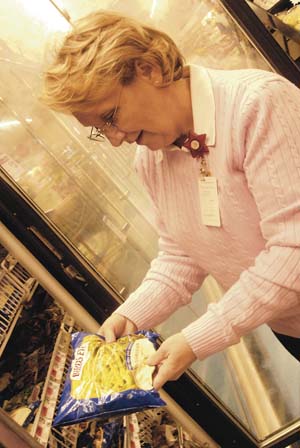
|
Jeanne Sager | Democrat
CAROL PARK OF the CRMC Diabetes Education Center checks out the nutrition content of french cut gree beans during her supermarket nutrition tour.
|
A Food Tour That Aims to be a Lifesaver
By Jeanne Sager
LIBERTY — December 14, 2007 — Think you know what you’re looking for when you read those food labels?
Guess again.
“I could ask 10 people what to look for, and they’d give me 10 different answers,” said Carol Park, a registered nurse and educator at the Catskill Regional Medical Center Diabetes Education Center.
“They’re all important,” she admitted, “but the most important thing is the serving size.”
Check that first, she advises her patients, because it will give you something to measure the other numbers against.
Still confused?
Park picked up two loaves of bread during a recent “free supermarket tour” at Garry’s Great American in Liberty.
At first glance, the numbers are daunting – calories, carbohydrates, sugars and all those percentage signs. One boasts whole grains, the other proclaims itself a dieter’s friend.
So how do you choose?
Weigh out how much you can ingest – the serving – against the number of positive and negative nutrients the item provides, Park suggests.
So what’s positive? What’s negative?
Ask 10 people, and, well, you’ll get 10 different answers.
That’s why the Diabetes Education Center has put together its own supermarket sweep, a walking tour of the grocery store with Park as the guide.
Carefully timed during the holiday season, the folks at the center want to help Sullivan County residents enjoy themselves without sacrificing their health – or giving up on taste.
“My mission is to seek out nutritious, delicious foods,” Park said before starting up a tour Tuesday at the Great American.
“I wanted to do it before the holidays so we could integrate some healthy food tips into our festivities,” she explained.
Park stopped by the checkout counters and chatted up the cashiers before her trek.
“They think people read labels,” she said. “I think people read labels too.
“They just don’t know what they’re looking for,” Park continued. “Being able to interpret that is important.”
Park’s tutorial starts simple, a trip around the perimeter of the store – where she suggests every shopper start.
There the foods are less likely to be processed, and more likely to pack a nutritious punch.
Venturing into the aisles laden with sugar-coated cereals and chocolate-drizzled donuts isn’t off limits, she said with a grin.
“You can [go in there] but you need to go armed with information,” she said.
They should know the daily fiber requirement – 25 to 30 grams.
They should know a little bit about that food ingredients list – looking out for words ending in “ose” or “itol” which translate into the sugars and sugar alcohols that can send someone’s blood sugar through the roof.
“It’s helpful to go shopping with a plan,” Park said. “And it’s helpful to go not on an empty stomach.”
Sounds obvious, but even people who bring a list can be easily swayed by the smells wafting out of the grocery’s bakery department.
And sometimes, that’s OK.
“People tell me, ‘All the good things that I like, I can’t have,’” Park said.
Not true.
“You just really have to be a smart shopper,” she explained.
To prove her point, Park wheeled her cart over to the frozen novelties section, pulling from the shelves two half-gallon containers of ice cream.
Brightly colored lettering on the one in her right hand read “No Sugar Added,” the other was a run-of-the-mill container of ice cream.
Turning them over, Park pointed out the sugar totals on the label.
The diet version had just one gram of sugar less.
The difference was negligible, Park said, not enough to make you sacrifice taste for so-called health.
“Sometimes, we hear in our brain that things are ‘healthy,’ but if you don’t read the label . . .” she said, trailing off as she picked up an example in the form of yogurt-covered raisins.
Alone the raisin is already high in sugar. Adding the yogurt covering often adds “bad” fat, the saturated fats Park recommends all her patients avoid.
There’s no question the grocery store is confusing – and not just for diabetics.
That’s why the supermarket tour has been opened up to everyone in the community who’d like a bit of simple advice.
“A calorie is the same no matter what it is,” Park said, “But there’s such a variety in food.
“We have so many different selections in front of us.”
At other markets in neighboring counties, similar tours cost as much as $45, but the Diabetes Education Center will be running its next session for free at Garry’s on Main Street in Liberty next Wednesday, Dec. 9, at 10 a.m.
Along with a free t-shirt, participants will have the chance to ask Park questions and follow her on the tour.
Limited to just 20 people, registration for the tour is recommended. Call Carol Park at 794-3300, ext. 2096 to sign up.

